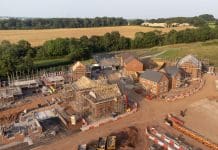Monthly construction output grew by a record 23.5% in June 2020 according to the latest ONS figures, but it remains 24.8% below pre-Covid-19 levels
Monthly construction output grew by a record 23.5% in June 2020, substantially higher than the previous record monthly growth of 7.6% in May 2020.
Despite this strong monthly growth, construction output in June 2020 remains comparatively low at 24.8% below the February 2020 level, which was before the full impact of the Covid-19 pandemic.
Quarterly output fell by a record 35.0% in Q2 2020 compared with Q1 2020 – this was driven by record falls of 35.2% in new work and 34.7% in repair and maintenance.
The decrease in new work (35.2%) in Q2 2020 was due to record quarterly falls in almost every new work sector – the largest contributor was private new housing, which fell by 51.2% compared with Q1 2020.
The 34.7% decrease in repair and maintenance in Q2 2020 was because of the record falls in all repair and maintenance sectors – the largest contributor was private housing repair and maintenance, which fell by 46.5% compared with Q1 2020.
New orders decreased by a record 51.1% in Q2 2020 – this decrease was due to record fall in both all other work and new housing, which declined by 51.9% and 49.0% respectively.
The value of New orders in Q22020 was £6,173m – this is the lowest level of new orders since records began in Q1 1964.
‘We must be building for the future’
Mike Derbyshire, head of planning at Bidwells, said: “It’s disappointing, but yet unsurprising, to see that construction output in June remains 24.8% below pre-Covid-19 levels.
“The stand out figure from today’s statistics however is private new housing output halved in Q2. While housebuilders will be spurred on by cuts to stamp duty and an extension to the government-backed Help to Buy equity scheme, more fundamental, long-lasting changes will be required if the industry is going to ramp up housing delivery post-crisis.
“Last week’s planning reforms were certainly a step in the right direction, but they do not go far enough. It will be a game-changer if the government does ensure local housing plans are developed and agreed in 30 months – down from the current 7 years – but there will still likely be under these proposals the age-old problem of local political indifference and in some cases outright hostility towards allocating housing through a local plan.
“The system must be brought into the digital age, to make it easier for people to engage and make it more representative of the many, not the few. We must be building for the future, so it’s only right that everyone has a say.”
‘Hurtling towards a later living black hole’
Eugene Marchese, co-founder and director at Guild Living, commented: “It is tempting to interpret today’s figures as a cause for celebration but the reality is not only that Britain is still in the midst of a housing crisis, it is also hurtling towards a later living black hole.
“While much is said about helping first-time buyers get a foot onto the property ladder, there is no getting away from the fact that we are not delivering enough purpose-built retirement communities to keep up with a growling population of older people.
“With around two million over-55s living in homes that are potentially damaging to their heath, mortgage lenders, local authorities and the government must go further to incentivise older people into home-moves that are better suited to their needs.
“Not only would a drive to develop more purpose-built later living communities ensure that we are capable of adequately caring for a growing population of older people, it would also encourage sensible downsizing and, therefore, free up housing stock for first-time buyers and growing families.”














